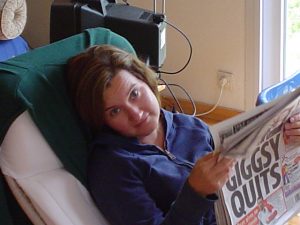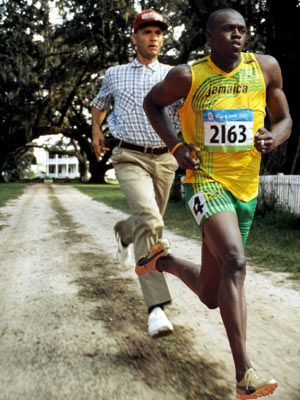The annual Rock ‘n’ Roll Las Vegas Marathon and ½ Marathon was attended by about 44,000 runners on Sunday Dec. 4, 2011. By Tuesday, complaints of illness were trickling in to the Southern Nevada Health District. By Thursday, traditional media reported on increasing complaints of barfing on the event’s Facebook page. An investigation was launched.
Within a week, health-types were able to say it wasn’t the water distributed during the race that made runners sick, quelling a rumor that had already taken on a life of its own.
that made runners sick, quelling a rumor that had already taken on a life of its own.
Below are excerpts from the final report, issued last week, identifying the first outbreak of sapovirus in Nevada and the emerging role of social media in epidemiological investigations.
Links to an epidemiology online survey were shared on the marathon’s Facebook page (with 25,732 followers) by members of the running community on four consecutive days starting on the day of release of the survey, and a total of 42 times within one week as part of a number of discussions among ill runners. Twenty-two people shared the survey link on Twitter, potentially reaching 17,982 followers. A total of 362 responses had been submitted within 12 hours of the release of the survey. After the survey had been posted for 4 days, a total of 1,146 surveys had been submitted. Of the 1,082 completed surveys, 578 (53.4%) were from persons who reported developing diarrhea or vomiting. Of these, 528 (91.3%) met the case definition.
Seventeen ill local runners were requested to provide stool specimens; specimens were provided by nine marathon runners and two symptomatic children of a symptomatic marathon runner. Specimens were collected between December 9, 2011 and December 11, 2011 (5-7 days after symptom onset), and all specimens submitted were formed stools. Two were positive by rRT-PCR for sapovirus and negative for all other tested pathogens at CDC and the SNPHL
The findings of this investigation point to the source of the sapovirus outbreak among marathon runners as a common exposure on the morning before the race, most likely at the health and fitness expo. It was not possible to determine which common exposure was responsible for the outbreak. The timing of the exposure and the incubation period of sapovirus resulted in the majority of cases becoming ill during the race or in the hours shortly after; however, exposure during the race was not the cause of the outbreak.
Sapoviruses (genus Sapovirus, family Caliciviridae) are a group of viruses that cause acute gastroenteritis in humans. Sapovirus is not as well-characterized as norovirus, but is thought to be similar to norovirus in that it has a short incubation period (1-2 days), low infectious dose, causes a self-limiting illness that is rarely serious with a significant percentage of asymptomatic infections, and is easily spread from person to person through fecal-oral transmission. Both infections cause diarrhea, although a lesser percentage of sapovirus patients develop vomiting as compared to norovirus patients.
Outbreaks of sapovirus have been reported in the literature, but reports of foodborne outbreaks and outbreaks among adults outside long-term care are rare and the majority of cases occur in children under 5 years of age. This outbreak represents the first outbreak of sapovirus in Southern Nevada and the first time the virus has been identified in the local population. However, sapovirus testing is not available locally and has not been previously ordered during an outbreak. Rather than representing a newly-introduced disease, the identification of the virus likely indicates that sapovirus circulates at low levels in the population but goes unidentified.
This investigation was also the health district’s foray into using social media as an investigative tool, rather than just as a method of disseminating information to the public. Using the active community of runners on Facebook and Twitter allowed for the rapid dissemination of the survey directly to the exposed population without a delay in requesting participant information from the race organizers. Comments posted to social media sites provided ongoing, real-time insight into the needs and concerns of the ill population, and provided a feel for the efficacy of health district investigation efforts. Comments about SNHD were overwhelmingly positive, and indicated a level of trust and willingness to cooperate from the community.
Ill and non-ill runners quickly responded to the survey, which allowed SNHD staff to rapidly identify ill persons for laboratory testing. It also allowed for a preliminary data analysis to be quickly completed, which allowed the water provided by race organizers, an early focus of complaints by runners, to be ruled out as a source of the outbreak. The water provided in the .jpeg) race was the same potable water that is distributed throughout Southern Nevada, and it was important to quickly determine if the general population was at risk of disease.
race was the same potable water that is distributed throughout Southern Nevada, and it was important to quickly determine if the general population was at risk of disease.
The ill persons identified by SNHD staff complied very quickly with the request to submit specimens for laboratory testing. The submission of stool samples for testing is often a difficult task due to the type of sample requested and the handling requirements. The ill persons were highly motivated to provide samples that could be used to identify the causative agent of the outbreak.
In the future, several steps should be implemented to improve the investigative process and to prevent disease at similar events. First, although the survey was developed quickly, a standard template should be developed to allow the rapid deployment of standardized surveys for illness. In addition, corresponding standard analytic tools should be developed to allow for the rapid analysis of survey data.
Next, SNHD should consider using social media more frequently to administer surveys given the appropriate audience; in this case, the use of Facebook was effective because there was an active community of marathon frequently posting and reading the marathon’s page. During a large event, it might be appropriate to set up a social media site for the event response. This would provide an additional avenue for SNHD to share information from the public, and following discussions would allow for real-time feedback on the needs and concerns of the public. However, the decision to launch a social media site should be thoroughly discussed prior to launch, as it would place SNHD in the role of moderating the discussion on the topic (for example, removing libelous comments or threats against employees). It would also necessitate the development of policies on the participation in such discussion by staff members on work time or personal time.
The complete report is available at: http://www.southernnevadahealthdistrict.org/download/stats-reports/rocknroll-marathon-sapovirus-outbreak-final-report.pdf.
 It wasn’t like we recorded Exile on Main Street (although we did some decent writing).
It wasn’t like we recorded Exile on Main Street (although we did some decent writing).

.jpeg) race was the same potable water that is distributed throughout Southern Nevada, and it was important to quickly determine if the general population was at risk of disease.
race was the same potable water that is distributed throughout Southern Nevada, and it was important to quickly determine if the general population was at risk of disease..jpg) sickened runners.
sickened runners. Dozens of runners posted stories on Facebook about nausea, vomiting and severe stomach pain after the race.
Dozens of runners posted stories on Facebook about nausea, vomiting and severe stomach pain after the race. possible source for illness complaints that have been posted on Facebook.
possible source for illness complaints that have been posted on Facebook.